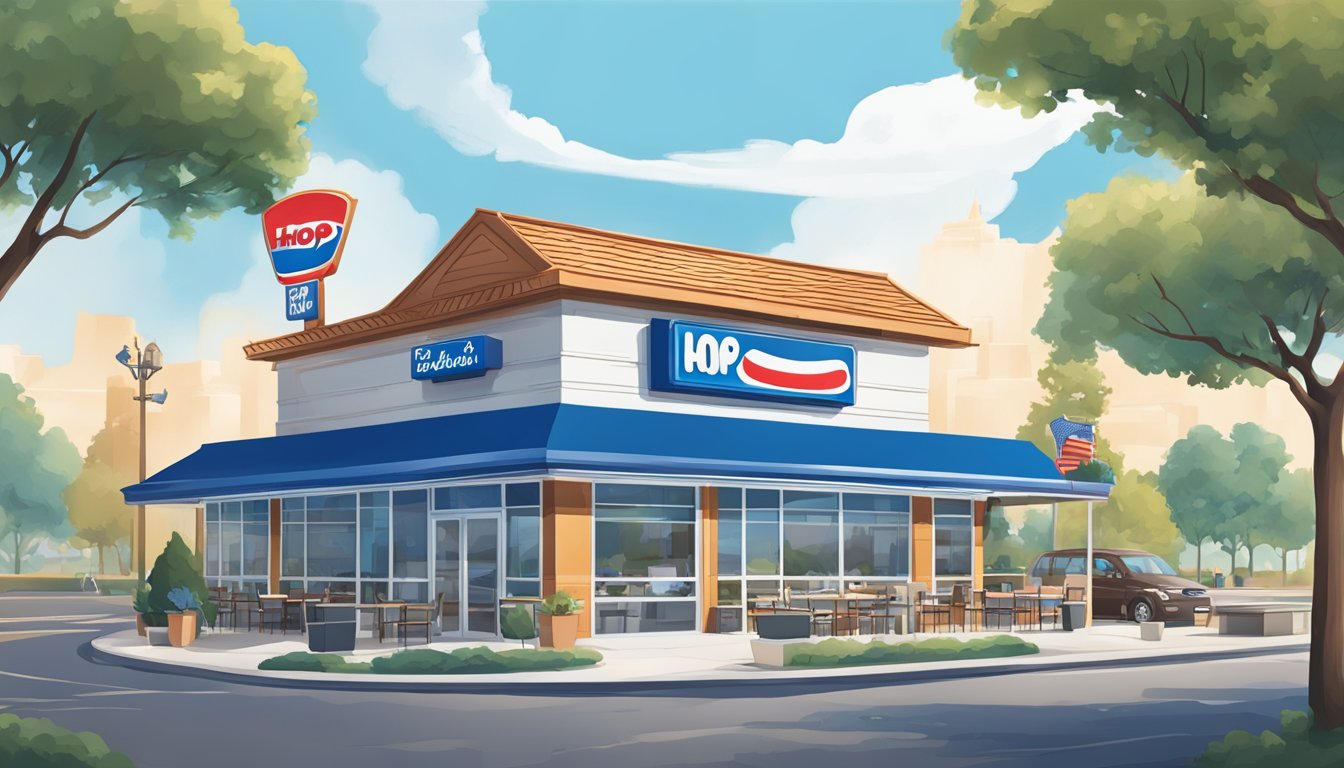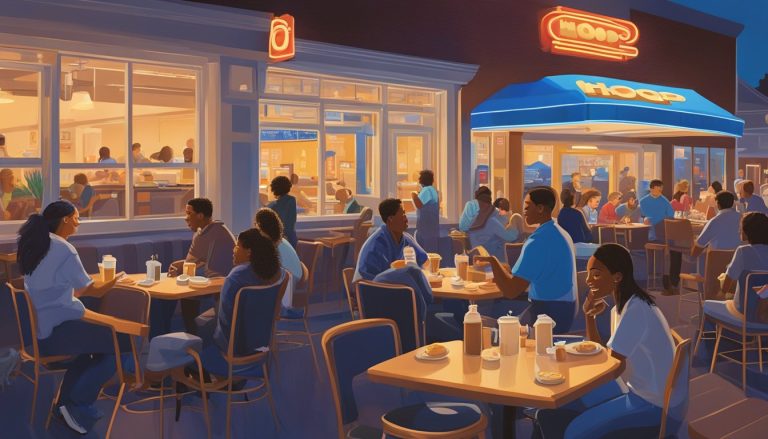IHOP, the International House of Pancakes, has come a long way since its modest beginnings in Toluca Lake, California. Founded in 1958 by Al and Jerry Lapin, this pancake house quickly captured the hearts and appetites of Americans with its delectable breakfast offerings. Today, IHOP boasts over 1,800 locations across more than 13 countries, solidifying its status as a global breakfast icon.
The journey from a single California restaurant to an international chain is a testament to IHOP’s enduring appeal and strategic growth. While the brand remains rooted in its American breakfast heritage, it has successfully adapted its menu and dining experience to suit diverse palates around the world. IHOP’s expansion into markets such as Canada, Mexico, Guatemala, Saudi Arabia, and India demonstrates its ability to transcend cultural boundaries while maintaining its core identity.
The History of IHOP and Its Founding Story

IHOP’s journey from a small pancake house to a global restaurant chain is marked by innovation and strategic growth. The company’s evolution includes significant branding changes and marketing campaigns that have shaped its identity.
The Evolution from a Single Location to a Major Chain
IHOP, or International House of Pancakes, began in 1958 in Toluca Lake, California. Al and Jerry Lapin founded the first restaurant, focusing on breakfast foods, particularly pancakes. The concept quickly gained popularity, and by 1960, IHOP had become a subsidiary of International Industries.
The 1960s and 1970s saw rapid expansion. IHOP’s menu diversified beyond breakfast items, attracting customers throughout the day. In 1973, the company went public, fueling further growth.
By the 1990s, IHOP had established itself as a major player in the family dining sector. The chain reached a significant milestone in 1998, with system-wide sales hitting $1 billion. IHOP began trading on the New York Stock Exchange under the symbol “IHP” that same year.
From IHOP to IHOB: Branding Changes and Impact
IHOP’s most notable branding change occurred in 2018 with the temporary switch to “IHOB”. This marketing campaign aimed to promote the chain’s burger offerings. The move generated significant buzz and media attention.
Despite reverting to IHOP, the campaign successfully increased awareness of the restaurant’s non-breakfast menu items. It demonstrated IHOP’s willingness to take risks with its brand identity to drive growth.
In recent years, IHOP has continued to innovate. The introduction of the SIMPLE & FIT menu in 2010 catered to health-conscious diners. By 2023, IHOP’s annual sales revenue reached approximately $3.56 billion, reflecting its strong market position and customer appeal.
Analyzing IHOP’s Business Model

IHOP’s success stems from its unique business model that combines franchising, strategic partnerships, and innovative restaurant concepts. This approach has enabled the company to expand rapidly while maintaining brand consistency and operational efficiency.
The Role of Franchisees in Expansion
Franchising forms the backbone of IHOP’s growth strategy. The company relies on franchisees to open and operate new locations, reducing capital requirements and spreading risk. Franchisees benefit from IHOP’s established brand recognition and proven business model.
IHOP provides comprehensive support to its franchisees, including training, marketing assistance, and operational guidance. This ensures consistent quality across locations while allowing for local market adaptations.
Multi-unit development agreements have become increasingly common, enabling experienced franchisees to open multiple IHOP restaurants in specific territories. This approach accelerates expansion and strengthens relationships with successful operators.
Dine Brands: The Synergy with Applebee’s
IHOP operates under the umbrella of Dine Brands Global, which also owns Applebee’s. This structure creates synergies and efficiencies for both restaurant chains.
Shared resources and expertise in areas such as supply chain management, technology implementation, and marketing strategies benefit both brands. The combined purchasing power of IHOP and Applebee’s allows for better negotiation with suppliers.
Dine Brands’ dual-brand portfolio provides diversification, with IHOP focusing primarily on breakfast and Applebee’s targeting the casual dining segment. This strategy helps mitigate risks associated with market fluctuations in specific dining categories.
Dual-Branded Restaurants and Their Advantages
IHOP has embraced the concept of dual-branded restaurants, particularly in partnership with Applebee’s. This innovative approach combines two distinct restaurant brands under one roof.
Dual-branded locations offer several advantages:
- Increased foot traffic throughout the day
- Reduced real estate and operational costs
- Enhanced customer choice and convenience
By leveraging the strengths of both IHOP and Applebee’s, these combined locations can attract a wider range of customers and optimize space utilization. This strategy has proven particularly effective in high-traffic areas and non-traditional locations such as airports and universities.
IHOP’s Menu Development and Dining Experience

IHOP’s menu has evolved significantly since its inception, expanding beyond pancakes to offer a diverse array of options for all meals. The restaurant has adapted to changing consumer preferences while maintaining its core identity as a breakfast destination.
Pancakes and Beyond: The Expansion of Menu Offerings
IHOP’s menu expansion has been a key driver of its success. While pancakes remain the cornerstone of its offerings, the chain has diversified to include a wide range of breakfast foods. Waffles, French toast, and omelettes have become popular alternatives. The menu now features savory options like burgers and sandwiches, catering to lunch and dinner crowds.
IHOP has introduced specialty pancake flavors and seasonal items to keep the menu fresh and exciting. These innovations have helped maintain customer interest and attract new diners. The chain also offers customization options, allowing guests to create their perfect meal.
Adapting to Changing Consumer Preferences
IHOP has shown a commitment to adapting its menu based on customer feedback and market trends. The restaurant has introduced healthier alternatives, including whole grain options and fresh fruit sides. Vegetarian and gluten-free items have been added to accommodate dietary restrictions.
In 2023, IHOP launched its largest menu renovation to date. This update aimed to enhance existing recipes and introduce new dishes that aligned with current food trends. The chain has also focused on improving the quality of ingredients used in its dishes.
IHOP has embraced technology to enhance the dining experience. Digital menus and ordering systems have been implemented in many locations, streamlining the ordering process.
Breakfast, Lunch, and Dinner: Diverse Menu for All Dayparts
IHOP has successfully positioned itself as an all-day dining destination. While breakfast remains its primary focus, the chain has developed robust lunch and dinner menus. This strategy has helped IHOP capture a larger share of the casual dining market.
The lunch menu features a variety of sandwiches, salads, and soups. For dinner, IHOP offers heartier options like steaks, chicken dishes, and seafood. The availability of breakfast items throughout the day has remained a unique selling point, allowing customers to enjoy pancakes and eggs at any time.
IHOP’s diverse menu has contributed to its strong presence in the family dining segment. The range of options caters to different tastes and dietary needs within a single group, making it an appealing choice for family outings.
Strategic Marketing and Building Brand Recognition

IHOP’s marketing strategies have played a crucial role in its growth from a local California diner to a global breakfast icon. The company has leveraged innovative campaigns, embraced digital platforms, and conducted thorough market analyses to solidify its position in the competitive restaurant industry.
A Case Study: National Pancake Day and Its Success
National Pancake Day stands out as one of IHOP’s most successful marketing initiatives. Launched in 2006, this annual event offers customers free short stacks of buttermilk pancakes in exchange for optional donations to charitable causes. The campaign has raised over $30 million for various organizations since its inception.
This philanthropic approach not only generates goodwill but also drives foot traffic and brand awareness. By aligning the brand with charitable causes, IHOP has created a positive association in consumers’ minds. The event’s timing, typically held in February or March, helps boost sales during slower winter months.
National Pancake Day’s success lies in its simplicity and appeal to customers’ desire for both value and social responsibility. The campaign’s viral nature on social media has further amplified its reach, making it a cornerstone of IHOP’s marketing calendar.
Leveraging Social Media and Online Ordering
IHOP has embraced digital platforms to enhance its marketing efforts and streamline customer experiences. The brand maintains an active presence on major social media platforms, engaging customers with visually appealing content, promotions, and interactive campaigns.
Key social media strategies include:
- User-generated content campaigns
- Influencer partnerships
- Timely posts related to holidays and events
- Behind-the-scenes glimpses of IHOP kitchens
The company has also invested in online ordering capabilities, recognizing the growing demand for convenience. IHOP’s mobile app and website allow customers to place orders for pickup or delivery, expanding the brand’s reach beyond traditional dine-in experiences.
These digital initiatives have helped IHOP stay relevant in a rapidly evolving market, particularly among younger demographics. By integrating online ordering with loyalty programs, IHOP has created additional touchpoints to engage customers and drive repeat business.
SWOT Analysis: Understanding IHOP’s Market Position
A SWOT analysis provides insights into IHOP’s current market position:
Strengths:
- Strong brand recognition
- Diverse menu offerings
- Established franchise model
Weaknesses:
- Heavy reliance on breakfast items
- Limited health-conscious options
- Inconsistent customer experiences across locations
Opportunities:
- International expansion
- Menu innovation (e.g., plant-based options)
- Enhanced delivery and takeout services
Threats:
- Increasing competition from fast-casual chains
- Changing consumer preferences towards healthier options
- Economic downturns affecting dining-out habits
This analysis helps IHOP identify areas for improvement and potential growth avenues. By addressing weaknesses and capitalizing on opportunities, the company can strengthen its competitive position and adapt to evolving market trends.
Global Expansion and International Markets

IHOP has transformed from a local California diner into a global breakfast powerhouse. The chain has successfully ventured into diverse markets across continents, adapting its offerings to suit local tastes while maintaining its core identity.
Breaking into New Markets: Asia, Europe, and Latin America
IHOP’s international journey began in Canada in 1969. The chain later expanded into Mexico, establishing a strong presence in North America. In recent years, IHOP has made significant inroads into Asia, with locations in Japan and South Korea. Europe has also become a target market, with Spain welcoming its first IHOP restaurant.
Latin America has proven to be a promising region for IHOP. The company opened its first restaurant in Lima, Peru in 2019, with plans for 25 locations by 2028. This expansion is expected to create over 600 new jobs in the area.
IHOP has also set its sights on the Middle East, recognizing the region’s growing economy and appetite for American cuisine.
Cultural Adaptation and Menu Innovation Overseas
IHOP’s success in international markets stems from its ability to adapt to local tastes while preserving its core offerings. In Asia, the chain has introduced rice-based dishes and green tea-flavored pancakes to appeal to local palates.
In Mexico, IHOP menus feature spicier options and incorporate traditional ingredients like chorizo. The company has also embraced local breakfast traditions in various countries, offering region-specific items alongside its classic pancakes and waffles.
IHOP’s international locations often feature unique decor elements that reflect the local culture, creating a blend of American diner atmosphere and regional flair.
Master Franchisees and Developers: Growing IHOP Worldwide
IHOP’s global expansion strategy relies heavily on partnerships with master franchisees and developers. These local partners possess invaluable knowledge of their markets, helping IHOP navigate cultural nuances and regulatory landscapes.
In Peru, IHOP partnered with Percapitals S.A.C. to drive its expansion efforts. Similar agreements exist in other countries, allowing IHOP to rapidly scale its international presence.
These partnerships often involve multi-unit development deals, ensuring a steady stream of new IHOP locations in target markets. Master franchisees are responsible for adapting IHOP’s concept to local preferences while maintaining the brand’s core values and quality standards.
IHOP’s Influence on the Restaurant Industry

IHOP has significantly shaped the restaurant industry, particularly in the breakfast segment. Its innovative approach to menu offerings, marketing strategies, and operational practices has set new standards for competitors and influenced consumer expectations.
Benchmarking Against Other Breakfast Chains
IHOP’s success has made it a benchmark for other breakfast chains. The company’s focus on all-day breakfast and diverse menu options has pushed competitors to expand their offerings. IHOP’s signature pancakes and friendly service have become industry standards.
Many chains now emulate IHOP’s family-friendly environment and extensive breakfast menu. This has led to increased competition and innovation in the breakfast segment. IHOP’s international expansion has also inspired other chains to consider global growth opportunities.
The company’s marketing campaigns, such as its temporary name change to IHOb to promote burgers, have demonstrated the power of creative branding in the restaurant industry.
Staying Ahead in the Fast Casual Segment
IHOP has adapted to changing consumer preferences by incorporating elements of the fast casual segment into its operations. The company has introduced mobile ordering and delivery services to cater to convenience-seeking customers.
IHOP’s menu innovations, including healthier options and customizable dishes, have helped it stay relevant in the competitive fast casual market. The chain’s ability to balance traditional favorites with trendy items has set an example for other restaurants.
To appeal to younger demographics, IHOP has redesigned its restaurants with modern decor and updated technology. This approach has influenced other chains to refresh their image and stay current with consumer expectations.
Economic Factors and their Influence on Operation
IHOP’s operations and strategies have been shaped by various economic factors, influencing the broader restaurant industry. The company’s franchise model has proven resilient during economic downturns, providing a blueprint for other chains.
During periods of economic uncertainty, IHOP has focused on value offerings to maintain customer loyalty. This strategy has been adopted by many competitors in the industry. The chain’s emphasis on breakfast sales has also demonstrated the importance of this meal category in driving restaurant traffic and revenue.
IHOP’s financial performance serves as an indicator of overall industry health. Its ability to navigate challenges such as rising food costs and labor shortages has provided insights for other restaurants facing similar issues.
Customer Centricity and the Role of Service
IHOP’s success hinges on its commitment to customer satisfaction and exceptional service. The restaurant chain prioritizes understanding customer needs and delivering a positive dining experience.
Analyzing Customer Satisfaction and Loyalty
IHOP regularly conducts customer surveys to gauge satisfaction levels. These surveys provide valuable insights into menu preferences, service quality, and overall experience. The company uses this data to refine its offerings and improve customer loyalty.
IHOP’s customer base spans diverse demographics, from families to late-night diners. To cater to this variety, the restaurant concept emphasizes flexibility in its menu and operating hours. This adaptability has contributed to IHOP’s strong customer retention rates.
The chain also implements loyalty programs to reward frequent customers. These programs offer perks such as discounts, birthday specials, and exclusive menu items, encouraging repeat visits and fostering a sense of belonging among patrons.
The Impact of Customer Service on IHOP’s Brand
IHOP’s brand identity is closely tied to its friendly service. The company invests heavily in staff training to ensure consistent, high-quality customer interactions across all locations. This focus on service has become a key differentiator in the competitive restaurant industry.
Customer feedback often highlights the welcoming atmosphere created by IHOP’s staff. Positive experiences shared on social media platforms have helped strengthen the brand’s reputation for hospitality. IHOP leverages these testimonials in marketing campaigns, further reinforcing its image as a customer-centric establishment.
The chain’s commitment to service extends beyond the dining room. IHOP has embraced digital platforms to enhance the customer experience, offering online ordering and a user-friendly mobile app. These initiatives have improved convenience for customers and expanded IHOP’s reach in the digital space.
New Trends and Adaptations in Dining

IHOP has embraced innovation to meet changing consumer preferences. The restaurant chain focuses on quality ingredients while expanding convenience options and diversifying its menu offerings.
Embracing Convenience through Delivery Services
IHOP recognized the growing demand for convenient dining options. The company partnered with major food delivery platforms to bring its pancakes and other menu items directly to customers’ homes. This move expanded IHOP’s reach beyond its physical locations, allowing patrons to enjoy their favorite meals without leaving their houses.
IHOP also developed a user-friendly mobile app for easy ordering and pickup. The app streamlined the takeout process, reducing wait times and enhancing customer satisfaction.
Menu Innovations: Responding to Dietary Trends
IHOP expanded its menu to cater to diverse dietary needs and preferences. The restaurant introduced healthier options, including a range of salads and protein-packed dishes. These additions appealed to health-conscious diners without compromising on taste.
The chain also experimented with new pancake flavors, blending traditional favorites with innovative combinations. Seasonal offerings and limited-time specials kept the menu fresh and exciting for regular customers.
IHOP added plant-based alternatives to its menu, addressing the growing demand for vegetarian and vegan options. These changes demonstrated IHOP’s commitment to adapting to evolving consumer tastes and dietary requirements.
The Future Vision of International House of Pancakes

IHOP aims to solidify its position as a global breakfast icon in the coming years. The chain plans to expand its global footprint beyond its current presence in countries like Mexico, Guatemala, Saudi Arabia, and India.
Market research will play a crucial role in IHOP’s expansion strategy. The company will analyze local tastes and preferences to tailor its offerings in new markets.
Menu innovation remains a key focus for IHOP. The brand will likely introduce new pancake flavors and breakfast items to keep customers engaged and attract new demographics.
IHOP recognizes the importance of enhancing its online presence. The company will invest in digital ordering platforms and mobile apps to streamline the customer experience.
To combat intense competition in the breakfast segment, IHOP may explore partnerships with food delivery services and expand its retail product line.
The chain will likely continue its efforts to modernize restaurant designs and improve operational efficiency. This could involve adopting new technologies to speed up service and reduce wait times.
IHOP’s future vision also includes strengthening its brand identity as a family-friendly destination. The company may introduce more interactive elements and promotions to appeal to younger generations.




